Analysis of the Current Situation of CO2 Satellite Observation
Highlights
- Compared with observations, OCO-2 and GOSAT satellites exhibit a general neg-ative bias over land with the best accuracy in spring.
- Satellites showed limited performance in tropical regions and biases in sub-regions like East and South Asia; ocean measurements had the largest spring biases and seasonal errors.
- Seasonal and regional biases, influenced by topography and aerosols, highlight the need for targeted corrections to improve CO2 monitoring.
- Better satellite retrievals over deserts suggest surface type impacts accuracy, guiding improvements in data interpretation for carbon flux research.
Abstract
1. Introduction
2. Data and Methods
2.1. Data
2.1.1. GOSAT
2.1.2. OCO-2
2.1.3. CarbonTracker
2.1.4. TCCON
2.2. Methods
2.2.1. Spatiotemporal Matching with CT
2.2.2. TransCom Region Mask
2.2.3. Spatiotemporal Matching with TCCON
2.2.4. Statistical Metrics
3. Results
3.1. Monthly Averaged Comparison Between Satellites and CT on the Regional Scale
3.1.1. Statistical Analysis over Land Regions
3.1.2. Statistical Analyses over Ocean Regions
3.1.3. Spatial Analyses of Differences Against CT over Land
3.2. Comparison of XCO2 Between Satellites and TCCON
4. Discussion
4.1. Sources of Retrieval Biases and Uncertainties
4.2. Advantages and Disadvantages of Satellite Retrieval Relative to CT
4.3. Other Suggestions
5. Conclusions
Supplementary Materials
Author Contributions
Funding
Data Availability Statement
Acknowledgments
Conflicts of Interest
Abbreviations
| AT | Atlantic Tropical |
| AUS | Australia |
| CAI | Cloud and Aerosol Imager |
| COCCON | COllaborative Carbon Column Observing Network |
| CO2 | Carbon Dioxide |
| CT | CarbonTracker |
| DJF | December, January and February |
| DQ-1 | Atmospheric Environment Monitoring Satellite |
| EATE | Eurasia Temperate |
| ENVISAT-2002-9A | Earth observation satellite Environmental Satellite |
| EP | East Pacific Tropical |
| ESA | European Space Agency |
| EUR | Europe |
| FTS | Fourier Transform Spectrometer |
| GHG | Greenhouse Gas |
| IT | Indian Tropical |
| ITCZ | Intertropical Convergence Zone |
| JJA | June, July and August |
| MAM | March, April and May |
| NA | North Atlantic |
| NABO | Northern American Boreal |
| NAF | Northern Africa |
| NATE | Northern American Temperate |
| NH | Northern hemisphere |
| NOAA | National Oceanic and Atmospheric Administration |
| NIES | National Institute for Environmental Studies |
| NP | North Pacific |
| NRT | Near-Real-Time |
| GOSAT | Greenhouse gases Observing Satellite |
| OCO-2 | Orbiting Carbon Observatory-2 |
| R | Correlation coefficient |
| R2 | Determination Coefficient |
| RMSE | Root Mean Square Error |
| SA | South Atlantic |
| SATE | Southern America Temperate |
| SAF | Southern Africa |
| SD | Standard deviation |
| SH | Southern hemisphere |
| SI | South Indian |
| SON | September, October and November |
| SP | South Pacific |
| SWIR | shortwave infrared |
| TANSAT | Carbon Dioxide Observation Satellite |
| TANSO | Thermal and Near-intrinsic Sensor for Carbon Observation |
| TCCON | Total Carbon Column Observing Network |
| TRAS | Tropical Asia |
| WP | West Pacific Tropical |
| XCO2 | column-averaged dry air molar fraction of atmospheric CO2 |
References
- IPCC. Climate Change 2023: Synthesis Report. Contribution of Working Groups I, II and III to the Sixth Assessment Report of the Intergovernmental Panel on Climate Change; IPCC: Geneva, Switzerland, 2023; pp. 35–115. [Google Scholar] [CrossRef]
- IPCC. The Earth’s Energy Budget, Climate Feedbacks and Climate Sensitivity. In Climate Change 2021—The Physical Science Basis: Working Group I Contribution to the Sixth Assessment Report of the Intergovernmental Panel on Climate Change; Intergovernmental Panel on Climate Change (IPCC); Cambridge University Press: Cambridge, UK, 2023; pp. 923–1054. ISBN 978-1-009-15788-9. [Google Scholar]
- Brovkin, V.; Lorenz, S.; Raddatz, T.; Ilyina, T.; Stemmler, I.; Toohey, M.; Claussen, M. What Was the Source of the Atmospheric CO2 Increase during the Holocene? Biogeosciences 2019, 16, 2543–2555. [Google Scholar] [CrossRef]
- Yang, Z.; Kagawa, S.; Li, J. Do Greenhouse Gas Emissions Drive Extreme Weather Conditions at the City Level in China? Evidence from Spatial Effects Analysis. Urban Clim. 2021, 37, 100812. [Google Scholar] [CrossRef]
- Doney, S.C.; Fabry, V.J.; Feely, R.A.; Kleypas, J.A. Ocean Acidification: The Other CO2 Problem. Annu. Rev. Mar. Sci. 2009, 1, 169–192. [Google Scholar] [CrossRef]
- Solomon, S.; Plattner, G.-K.; Knutti, R.; Friedlingstein, P. Irreversible Climate Change Due to Carbon Dioxide Emissions. Proc. Natl. Acad. Sci. USA 2009, 106, 1704–1709. [Google Scholar] [CrossRef] [PubMed]
- Jacobson, T.A.; Kler, J.S.; Hernke, M.T.; Braun, R.K.; Meyer, K.C.; Funk, W.E. Direct Human Health Risks of Increased Atmospheric Carbon Dioxide. Nat. Sustain. 2019, 2, 691–701. [Google Scholar] [CrossRef]
- Wunch, D.; Toon, G.C.; Blavier, J.-F.L.; Washenfelder, R.A.; Notholt, J.; Connor, B.J.; Griffith, D.W.T.; Sherlock, V.; Wennberg, P.O. The Total Carbon Column Observing Network. Philos. Trans. R. Soc. A Math. Phys. Eng. Sci. 2011, 369, 2087–2112. [Google Scholar] [CrossRef]
- Crisp, D.; Dolman, H.; Tanhua, T.; McKinley, G.A.; Hauck, J.; Bastos, A.; Sitch, S.; Eggleston, S.; Aich, V. How Well Do We Understand the Land-Ocean-Atmosphere Carbon Cycle? Rev. Geophys. 2022, 60, e2021RG000736. [Google Scholar] [CrossRef]
- Laughner, J.L.; Toon, G.C.; Mendonca, J.; Petri, C.; Roche, S.; Wunch, D.; Blavier, J.-F.; Griffith, D.W.T.; Heikkinen, P.; Keeling, R.F.; et al. The Total Carbon Column Observing Network’s GGG2020 Data Version. Earth Syst. Sci. Data 2024, 16, 2197–2260. [Google Scholar] [CrossRef]
- Fan, C.; Yang, J.; Liu, J.; Bu, L.; Wang, Q.; Wei, C.; Zhang, Y.; Zhu, X.; Li, S.; Zang, H.; et al. Airborne Atmospheric Carbon Dioxide Measurement Using 1.5 µm Laser Double-Pulse IPDA Lidar over a Desert Area. Appl. Opt. 2024, 63, 2121–2131. [Google Scholar] [CrossRef]
- Wang, Q.; Mustafa, F.; Bu, L.; Zhu, S.; Liu, J.; Chen, W. Atmospheric Carbon Dioxide Measurement from Aircraft and Comparison with OCO-2 and CarbonTracker Model Data. Atmos. Meas. Tech. 2021, 14, 6601–6617. [Google Scholar] [CrossRef]
- Mitchell, K.A.; Doney, S.C.; Keppel-Aleks, G. Characterizing Average Seasonal, Synoptic, and Finer Variability in Orbiting Carbon Observatory-2 XCO2 Across North America and Adjacent Ocean Basins. J. Geophys. Res. Atmos. 2023, 128, e2022JD036696. [Google Scholar] [CrossRef]
- Machida, T.; Matsueda, H.; Sawa, Y.; Nakagawa, Y.; Hirotani, K.; Kondo, N.; Goto, K.; Nakazawa, T.; Ishikawa, K.; Ogawa, T. Worldwide Measurements of Atmospheric CO2 and Other Trace Gas Species Using Commercial Airlines. J. Atmos. Ocean. Technol. 2008, 25, 1744–1754. [Google Scholar] [CrossRef]
- Zhao, S.; Liu, M.; Tao, M.; Zhou, W.; Lu, X.; Xiong, Y.; Li, F.; Wang, Q. The Role of Satellite Remote Sensing in Mitigating and Adapting to Global Climate Change. Sci. Total Environ. 2023, 904, 166820. [Google Scholar] [CrossRef]
- Zandbergen, R.; Otten, M.; Righetti, P.L.; Kuijper, D.; Dow, J.M. Routine Operational and High-Precision Orbit Determination of Envisat. Adv. Space Res. 2003, 31, 1953–1958. [Google Scholar] [CrossRef]
- Yokota, T.; Yoshida, Y.; Eguchi, N.; Ota, Y.; Tanaka, T.; Watanabe, H.; Maksyutov, S. Global Concentrations of CO2 and CH4 Retrieved from GOSAT: First Preliminary Results. SOLA 2009, 5, 160–163. [Google Scholar] [CrossRef]
- Yoshida, Y.; Ota, Y.; Eguchi, N.; Kikuchi, N.; Nobuta, K.; Tran, H.; Morino, I.; Yokota, T. Retrieval Algorithm for CO2 and CH4 Column Abundances from Short-Wavelength Infrared Spectral Observations by the Greenhouse Gases Observing Satellite. Atmos. Meas Tech. 2011, 4, 717–734. [Google Scholar] [CrossRef]
- Someya, Y.; Yoshida, Y.; Ohyama, H.; Nomura, S.; Kamei, A.; Morino, I.; Mukai, H.; Matsunaga, T.; Laughner, J.L.; Velazco, V.A.; et al. Update on the GOSAT TANSO–FTS SWIR Level 2 Retrieval Algorithm. Atmos. Meas Tech. 2023, 16, 1477–1501. [Google Scholar] [CrossRef]
- Wunch, D.; Wennberg, P.O.; Osterman, G.; Fisher, B.; Naylor, B.; Roehl, C.M.; O’Dell, C.; Mandrake, L.; Viatte, C.; Kiel, M.; et al. Comparisons of the Orbiting Carbon Observatory-2 (OCO-2) XCO2 Measurements with TCCON. Atmos. Meas Tech. 2017, 10, 2209–2238. [Google Scholar] [CrossRef]
- O’Dell, C.W.; Eldering, A.; Wennberg, P.O.; Crisp, D.; Gunson, M.R.; Fisher, B.; Frankenberg, C.; Kiel, M.; Lindqvist, H.; Mandrake, L.; et al. Improved Retrievals of Carbon Dioxide from Orbiting Carbon Observatory-2 with the Version 8 ACOS Algorithm. Atmos. Meas Tech. 2018, 11, 6539–6576. [Google Scholar] [CrossRef]
- Taylor, T.E.; O’Dell, C.W.; Baker, D.; Bruegge, C.; Chang, A.; Chapsky, L.; Chatterjee, A.; Cheng, C.; Chevallier, F.; Crisp, D.; et al. Evaluating the Consistency between OCO-2 and OCO-3 XCO2 Estimates Derived from the NASA ACOS Version 10 Retrieval Algorithm. Atmos. Meas Tech. 2023, 16, 3173–3209. [Google Scholar] [CrossRef]
- Taylor, T.E.; O’Dell, C.W.; Frankenberg, C.; Partain, P.T.; Cronk, H.Q.; Savtchenko, A.; Nelson, R.R.; Rosenthal, E.J.; Chang, A.Y.; Fisher, B.; et al. Orbiting Carbon Observatory-2 (OCO-2) Cloud Screening Algorithms: Validation against Collocated MODIS and CALIOP Data. Atmos. Meas Tech. 2016, 9, 973–989. [Google Scholar] [CrossRef]
- Bie, N.; Lei, L.; Zeng, Z.; Cai, B.; Yang, S.; He, Z.; Wu, C.; Nassar, R. Regional Uncertainty of GOSAT XCO2 Retrievals in China: Quantification and Attribution. Atmos. Meas Tech. 2018, 11, 1251–1272. [Google Scholar] [CrossRef]
- Virtanen, T.H.; Sundström, A.-M.; Suhonen, E.; Lipponen, A.; Arola, A.; O’Dell, C.; Nelson, R.R.; Lindqvist, H. A Global Perspective on CO2 Satellite Observations in High AOD Conditions. Atmos. Meas Tech. 2025, 18, 929–952. [Google Scholar] [CrossRef]
- Mengistu, A.G.; Tsidu, G.M. On the Performance of Satellite-Based Observations of XCO2 in Capturing the NOAA Carbon Tracker Model and Ground-Based Flask Observations over Africa’s Land Mass. Atmos. Meas Tech. 2020, 13, 4009–4033. [Google Scholar] [CrossRef]
- Zheng, J.; Zhang, H.; Zhang, S. Comparison of Atmospheric Carbon Dioxide Concentrations Based on GOSAT, OCO-2 Observations and Ground-Based TCCON Data. Remote Sens. 2023, 15, 5172. [Google Scholar] [CrossRef]
- Mikkonen, A.; Lindqvist, H.; Peltoniemi, J.; Tamminen, J. Non-Lambertian Snow Surface Reflection Models for Simulated Top-of-the-Atmosphere Radiances in the NIR and SWIR Wavelengths. J. Quant. Spectrosc. Radiat. Transf. 2024, 315, 108892. [Google Scholar] [CrossRef]
- Kiel, M.; O’Dell, C.W.; Fisher, B.; Eldering, A.; Nassar, R.; MacDonald, C.G.; Wennberg, P.O. How Bias Correction Goes Wrong: Measurement of XCO2 Affected by Erroneous Surface Pressure Estimates. Atmos. Meas Tech. 2019, 12, 2241–2259. [Google Scholar] [CrossRef]
- Jacobs, N.; O’Dell, C.W.; Taylor, T.E.; Logan, T.L.; Byrne, B.; Kiel, M.; Kivi, R.; Heikkinen, P.; Merrelli, A.; Payne, V.H.; et al. The Importance of Digital Elevation Model Accuracy in XCO2 Retrievals: Improving the Orbiting Carbon Observatory 2 Atmospheric Carbon Observations from Space Version 11 Retrieval Product. Atmos. Meas Tech. 2024, 17, 1375–1401. [Google Scholar] [CrossRef]
- Kataoka, F.; Crisp, D.; Taylor, T.E.; O’Dell, C.W.; Kuze, A.; Shiomi, K.; Suto, H.; Bruegge, C.; Schwandner, F.M.; Rosenberg, R.; et al. The Cross-Calibration of Spectral Radiances and Cross-Validation of CO2 Estimates from GOSAT and OCO-2. Remote Sens. 2017, 9, 1158. [Google Scholar] [CrossRef]
- Kong, Y.; Chen, B.; Measho, S. Spatio-Temporal Consistency Evaluation of XCO2 Retrievals from GOSAT and OCO-2 Based on TCCON and Model Data for Joint Utilization in Carbon Cycle Research. Atmosphere 2019, 10, 354. [Google Scholar] [CrossRef]
- Liang, A.; Gong, W.; Han, G.; Xiang, C. Comparison of Satellite-Observed XCO2 from GOSAT, OCO-2, and Ground-Based TCCON. Remote Sens. 2017, 9, 1033. [Google Scholar] [CrossRef]
- Yoshida, Y.; Kikuchi, N.; Morino, I.; Uchino, O.; Oshchepkov, S.; Bril, A.; Saeki, T.; Schutgens, N.; Toon, G.C.; Wunch, D.; et al. Improvement of the Retrieval Algorithm for GOSAT SWIR XCO2 and XCH4 and Their Validation Using TCCON Data. Atmos. Meas Tech. 2013, 6, 1533–1547. [Google Scholar] [CrossRef]
- Fang, J.; Chen, B.; Zhang, H.; Dilawar, A.; Guo, M.; Liu, C.; Liu, S.; Gemechu, T.M.; Zhang, X. Global Evaluation and Intercomparison of XCO2 Retrievals from GOSAT, OCO-2, and TANSAT with TCCON. Remote Sens. 2023, 15, 5073. [Google Scholar] [CrossRef]
- Chen, Y.; Cheng, J.; Song, X.; Liu, S.; Sun, Y.; Yu, D.; Fang, S. Global-Scale Evaluation of XCO2 Products from GOSAT, OCO-2 and CarbonTracker Using Direct Comparison and Triple Collocation Method. Remote Sens. 2022, 14, 5635. [Google Scholar] [CrossRef]
- Friedlingstein, P.; Jones, M.W.; O’Sullivan, M.; Andrew, R.M.; Bakker, D.C.E.; Hauck, J.; Le Quéré, C.; Peters, G.P.; Peters, W.; Pongratz, J.; et al. Global Carbon Budget 2021. Earth Syst. Sci. Data 2022, 14, 1917–2005. [Google Scholar] [CrossRef]
- Peiro, H.; Crowell, S.; Schuh, A.; Baker, D.F.; O’Dell, C.; Jacobson, A.R.; Chevallier, F.; Liu, J.; Eldering, A.; Crisp, D.; et al. Four Years of Global Carbon Cycle Observed from the Orbiting Carbon Observatory 2 (OCO-2) Version 9 and in Situ Data and Comparison to OCO-2 Version 7. Atmos. Chem. Phys. 2022, 22, 1097–1130. [Google Scholar] [CrossRef]
- Byrne, B.; Baker, D.F.; Basu, S.; Bertolacci, M.; Bowman, K.W.; Carroll, D.; Chatterjee, A.; Chevallier, F.; Ciais, P.; Cressie, N.; et al. National CO2 Budgets (2015–2020) Inferred from Atmospheric CO2 Observations in Support of the Global Stocktake. Earth Syst. Sci. Data 2023, 15, 963–1004. [Google Scholar] [CrossRef]
- Zhang, H.; Chen, B.; Xu, G.; Yan, J.; Che, M.; Chen, J.; Fang, S.; Lin, X.; Sun, S. Comparing Simulated Atmospheric Carbon Dioxide Concentration with GOSAT Retrievals. Sci. Bull. 2015, 60, 380–386. [Google Scholar] [CrossRef]
- Gaubert, B.; Stephens, B.B.; Basu, S.; Chevallier, F.; Deng, F.; Kort, E.A.; Patra, P.K.; Peters, W.; Rödenbeck, C.; Saeki, T.; et al. Global Atmospheric CO2 Inverse Models Converging on Neutral Tropical Land Exchange, but Disagreeing on Fossil Fuel and Atmospheric Growth Rate. Biogeosciences 2019, 16, 117–134. [Google Scholar] [CrossRef]
- Metz, E.-M.; Vardag, S.N.; Basu, S.; Jung, M.; Butz, A. Seasonal and Interannual Variability in CO2 Fluxes in Southern Africa Seen by GOSAT. Biogeosciences 2025, 22, 555–584. [Google Scholar] [CrossRef]
- Müller, A.; Tanimoto, H.; Sugita, T.; Machida, T.; Nakaoka, S.; Patra, P.K.; Laughner, J.; Crisp, D. New Approach to Evaluate Satellite-Derived XCO2 over Oceans by Integrating Ship and Aircraft Observations. Atmos. Chem. Phys. 2021, 21, 8255–8271. [Google Scholar] [CrossRef]
- National Institute for Environmental Studies (NIES). Release Note of Bias-corrected FTS SWIR Level 2 CO2 Product (V03.05) for General Users. Available online: https://data2.gosat.nies.go.jp/GosatDataArchiveService/doc/GU/ReleaseNote_FTSSWIRL2_BiasCorrCO2_V03.05_GU_en.pdf (accessed on 15 August 2024).
- GOSAT Website. Available online: https://data2.gosat.nies.go.jp/ (accessed on 15 August 2024).
- OCO-2/OCO-3 Science Team; Payne, V.; Chatterjee, A. OCO-2 Level 2 Bias-Corrected XCO2 and Other Select Fields from the Full-Physics Retrieval Aggregated as Daily Files, Retrospective Processing V11.1r; Goddard Earth Sciences Data and Information Services Center (GES DISC): Greenbelt, MD, USA. [CrossRef]
- OCO-2/OCO-3 Science Team; Payne, V.; Chatterjee, A. User Guide OCO-2 V11.1r. Available online: https://docserver.gesdisc.eosdis.nasa.gov/public/project/OCO/OCO2_V11.1_OCO3_V10_L2_Data_Users_Guide_v3.0_RevA.pdf (accessed on 12 July 2025).
- Jacobson, A.R.; Schuldt, K.N.; Tans, P.; Andrews, A.; Miller, J.B.; Oda, T.; Basu, S.; Mund, J.; Weir, B.; Ott, L.; et al. CarbonTracker CT-NRT.v2024-1. 2024. Available online: https://doi.org/10.15138/3RE5-3Y28 (accessed on 5 September 2024).
- Jacobson, A.R.; Schuldt, K.N.; Tans, P.; Andrews, A.; Miller, J.B.; Oda, T.; Basu, S.; Mund, J.; Weir, B.; Ott, L.; et al. CarbonTracker Documentation CT2022 Release. 2023. Available online: https://www.gml.noaa.gov/ccgg/carbontracker/CT2022_doc.pdf (accessed on 5 September 2024).
- TCCON Data Archive. Available online: https://tccondata.org/ (accessed on 15 August 2024).
- Morino, I.; Velazco, V.A.; Hori, A.; Uchino, O.; Griffith, D.W.T. TCCON Data from Burgos, Ilocos Norte (PH), Release GGG2020.R0. 2022. Available online: https://doi.org/10.14291/tccon.ggg2020.burgos01.R0 (accessed on 15 August 2024).
- Wennberg, P.O.; Roehl, C.M.; Wunch, D.; Blavier, J.-F.; Toon, G.C.; Allen, N.T.; Treffers, R.; Laughner, J. TCCON Data from Caltech (US), Release GGG2020.R0. 2022. Available online: https://doi.org/10.14291/tccon.ggg2020.pasadena01.R0 (accessed on 15 August 2024).
- Deutscher, N.M.; Griffith, D.W.T.; Paton-Walsh, C.; Velazco, V.A.; Wennberg, P.O.; Blavier, J.-F.; Washenfelder, R.A.; Yavin, Y.; Keppel-Aleks, G.; Toon, G.C.; et al. TCCON Data from Darwin (AU), Release GGG2020.R0. 2023. Available online: https://doi.org/10.14291/tccon.ggg2020.darwin01.R0 (accessed on 15 August 2024).
- Wunch, D.; Mendonca, J.; Colebatch, O.; Allen, N.T.; Blavier, J.-F.; Kunz, K.; Roche, S.; Hedelius, J.; Neufeld, G.; Springett, S.; et al. TCCON Data from East Trout Lake, SK (CA), Release GGG2020.R0. 2022. Available online: https://doi.org/10.14291/tccon.ggg2020.easttroutlake01.R0 (accessed on 15 August 2024).
- Iraci, L.T.; Podolske, J.R.; Roehl, C.; Wennberg, P.O.; Blavier, J.-F.; Allen, N.; Wunch, D.; Osterman, G.B. TCCON Data from Edwards (US), Release GGG2020.R0. 2022. Available online: https://doi.org/10.14291/tccon.ggg2020.edwards01.R0 (accessed on 15 August 2024).
- Sussmann, R.; Rettinger, M. TCCON Data from Garmisch (DE), Release GGG2020.R0. 2023. Available online: https://doi.org/10.14291/tccon.ggg2020.garmisch01.R0 (accessed on 15 August 2024).
- Liu, C.; Wang, W.; Sun, Y.; Shan, C. TCCON Data from Hefei (PRC), Release GGG2020.R1. 2023. Available online: https://doi.org/10.14291/tccon.ggg2020.hefei01.R1 (accessed on 15 August 2024).
- Weidmann, D.; Brownsword, R.; Doniki, S. TCCON Data from Harwell, Oxfordshire (UK), Release GGG2020.R0. 2023. Available online: https://doi.org/10.14291/tccon.ggg2020.harwell01.R0 (accessed on 15 August 2024).
- García, O.E.; Schneider, M.; Herkommer, B.; Gross, J.; Hase, F.; Blumenstock, T.; Sepúlveda, E. TCCON Data from Izana (ES), Release GGG2020.R1. 2022. Available online: https://doi.org/10.14291/tccon.ggg2020.izana01.R1 (accessed on 15 August 2024).
- Hase, F.; Herkommer, B.; Groß, J.; Blumenstock, T.; Kiel, M.Ä.; Dohe, S. TCCON Data from Karlsruhe (DE), Release GGG2020.R1. 2023. Available online: https://doi.org/10.14291/tccon.ggg2020.karlsruhe01.R1 (accessed on 15 August 2024).
- Pollard, D.F.; Robinson, J.; Shiona, H. TCCON Data from Lauder (NZ), Release GGG2020.R0. 2022. Available online: https://doi.org/10.14291/tccon.ggg2020.lauder03.R0 (accessed on 15 August 2024).
- Wennberg, P.O.; Wunch, D.; Roehl, C.M.; Blavier, J.-F.; Toon, G.C.; Allen, N.T. TCCON Data from Lamont (US), Release GGG2020.R0. 2022. Available online: https://doi.org/10.14291/tccon.ggg2020.lamont01.R0 (accessed on 15 August 2024).
- Petri, C.; Vrekoussis, M.; Rousogenous, C.; Warneke, T.; Sciare, J.; Notholt, J. TCCON Data from Nicosia (CY), Release GGG2020.R1. 2024. Available online: https://doi.org/10.14291/tccon.ggg2020.nicosia01.R1 (accessed on 15 August 2024).
- Buschmann, M.; Petri, C.; Palm, M.; Warneke, T.; Notholt, J. TCCON Data from Ny-ålesund, Svalbard (NO), Release GGG2020.R0. 2022. Available online: https://doi.org/10.14291/tccon.ggg2020.nyalesund01.R0 (accessed on 15 August 2024).
- Warneke, T.; Petri, C.; Notholt, J.; Buschmann, M. TCCON Data from Orléans (FR), Release GGG2020.R1. 2024. Available online: https://doi.org/10.14291/tccon.ggg2020.orleans01.R1 (accessed on 15 August 2024).
- Té, Y.; Jeseck, P.; Janssen, C. TCCON Data from Paris (FR), Release GGG2020.R0. 2022. Available online: https://doi.org/10.14291/tccon.ggg2020.paris01.R0 (accessed on 15 August 2024).
- Wennberg, P.O.; Roehl, C.M.; Wunch, D.; Toon, G.C.; Blavier, J.-F.; Washenfelder, R.; Keppel-Aleks, G.; Allen, N.T. TCCON Data from Park Falls (US), Release GGG2020.R1. 2022. Available online: https://doi.org/10.14291/tccon.ggg2020.parkfalls01.R1 (accessed on 15 August 2024).
- Morino, I.; Ohyama, H.; Hori, A.; Ikegami, H. TCCON Data from Rikubetsu (JP), Release GGG2020.R0. 2022. Available online: https://doi.org/10.14291/tccon.ggg2020.rikubetsu01.R0 (accessed on 15 August 2024).
- Kivi, R.; Heikkinen, P.; Kyrö, E. TCCON Data from Sodankylä (FI), Release GGG2020.R0. 2022. Available online: https://doi.org/10.14291/tccon.ggg2020.sodankyla01.R0 (accessed on 15 August 2024).
- Deutscher, N.M.; Griffith, D.W.T.; Paton-Walsh, C.; Jones, N.B.; Velazco, V.A.; Wilson, S.R.; Macatangay, R.C.; Kettlewell, G.C.; Buchholz, R.R.; Riggenbach, M.O.; et al. TCCON Data from Wollongong (AU), Release GGG2020.R0. 2023. Available online: https://doi.org/10.14291/tccon.ggg2020.wollongong01.R0 (accessed on 15 August 2024).
- Zhou, M.; Wang, P.; Kumps, N.; Hermans, C.; Nan, W. TCCON Data from Xianghe, China, Release GGG2020.R0. 2022. Available online: https://doi.org/10.14291/tccon.ggg2020.xianghe01.R0 (accessed on 15 August 2024).
- Gurney, K.R.; Law, R.M.; Denning, A.S.; Rayner, P.J.; Baker, D.; Bousquet, P.; Bruhwiler, L.; Chen, Y.-H.; Ciais, P.; Fan, S.; et al. Towards Robust Regional Estimates of CO2 Sources and Sinks Using Atmospheric Transport Models. Nature 2002, 415, 626–630. [Google Scholar] [CrossRef]
- CarbonTracker CT2022 Download. Available online: https://gml.noaa.gov/ccgg/carbontracker/download.php (accessed on 28 June 2025).
- Zhang, L.; Sun, R.; Xu, Z.; Qiao, C.; Jiang, G. Diurnal and Seasonal Variations in Carbon Dioxide Exchange in Ecosystems in the Zhangye Oasis Area, Northwest China. PLoS ONE 2015, 10, e0120660. [Google Scholar] [CrossRef]
- Munassar, S.; Rödenbeck, C.; Gałkowski, M.; Koch, F.-T.; Totsche, K.U.; Botía, S.; Gerbig, C. To What Extent Does the CO2 Diurnal Cycle Impact Flux Estimates Derived from Global and Regional Inversions? Atmos. Chem. Phys. 2025, 25, 639–656. [Google Scholar] [CrossRef]
- Crowell, S.; Baker, D.; Schuh, A.; Basu, S.; Jacobson, A.R.; Chevallier, F.; Liu, J.; Deng, F.; Feng, L.; McKain, K.; et al. The 2015–2016 Carbon Cycle as Seen from OCO-2 and the Global in Situ Network. Atmos. Chem. Phys. 2019, 19, 9797–9831. [Google Scholar] [CrossRef]
- Sreenivas, G.; Mahesh, P.; Subin, J.; Kanchana, A.L.; Rao, P.V.N.; Dadhwal, V.K. Influence of Meteorology and Interrelationship with Greenhouse Gases (CO2 and CH4) at a Suburban Site of India. Atmos. Chem. Phys. 2016, 16, 3953–3967. [Google Scholar] [CrossRef]
- Nalini, K.; Uma, K.N.; Sijikumar, S.; Tiwari, Y.K.; Ramachandran, R. Satellite- and Ground-Based Measurements of CO2 over the Indian Region: Its Seasonal Dependencies, Spatial Variability, and Model Estimates. Int. J. Remote Sens. 2018, 39, 7881–7900. [Google Scholar] [CrossRef]
- Wu, R.; Chen, G. Contrasting Cloud Regimes and Associated Rainfall over the South Asian and East Asian Monsoon Regions. J. Clim. 2021, 34, 3663–3681. [Google Scholar] [CrossRef]
- Stein, T.H.M.; Parker, D.J.; Delanoë, J.; Dixon, N.S.; Hogan, R.J.; Knippertz, P.; Maidment, R.I.; Marsham, J.H. The Vertical Cloud Structure of the West African Monsoon: A 4 Year Climatology Using CloudSat and CALIPSO. J. Geophys. Res. Atmos. 2011, 116. [Google Scholar] [CrossRef]
- Hao, W.M.; Liu, M.-H. Spatial and Temporal Distribution of Tropical Biomass Burning. Glob. Biogeochem. Cycle 1994, 8, 495–503. [Google Scholar] [CrossRef]
- Roteta, E.; Bastarrika, A.; Padilla, M.; Storm, T.; Chuvieco, E. Development of a Sentinel-2 Burned Area Algorithm: Generation of a Small Fire Database for Sub-Saharan Africa. Remote Sens. Environ. 2019, 222, 1–17. [Google Scholar] [CrossRef]
- Nguyen, H.M.; Wooster, M.J. Advances in the Estimation of High Spatio-Temporal Resolution Pan-African Top-down Biomass Burning Emissions Made Using Geostationary Fire Radiative Power (FRP) and MAIAC Aerosol Optical Depth (AOD) Data. Remote Sens. Environ. 2020, 248, 111971. [Google Scholar] [CrossRef]
- Inoue, M.; Morino, I.; Uchino, O.; Nakatsuru, T.; Yoshida, Y.; Yokota, T.; Wunch, D.; Wennberg, P.O.; Roehl, C.M.; Griffith, D.W.T.; et al. Bias Corrections of GOSAT SWIR XCO2 and XCH4 with TCCON Data and Their Evaluation Using Aircraft Measurement Data. Atmos. Meas. Tech. 2016, 9, 3491–3512. [Google Scholar] [CrossRef]
- Someya, Y.; Yoshida, Y. Evaluating Radiometric Responsivity Degradations of TANSO-FTS/GOSAT Using Principal Component Analysis. J. Atmos. Ocean. Technol. 2020, 37, 1877–1890. [Google Scholar] [CrossRef]
- Frey, M.M.; Hase, F.; Blumenstock, T.; Dubravica, D.; Groß, J.; Göttsche, F.; Handjaba, M.; Amadhila, P.; Mushi, R.; Morino, I.; et al. Long-Term Column-Averaged Greenhouse Gas Observations Using a COCCON Spectrometer at the High-Surface-Albedo Site in Gobabeb, Namibia. Atmos. Meas. Tech. 2021, 14, 5887–5911. [Google Scholar] [CrossRef]
- Sha, M.K.; Das, S.; Frey, M.M.; Dubravica, D.; Alberti, C.; Baier, B.C.; Balis, D.; Bezanilla, A.; Blumenstock, T.; Boesch, H.; et al. Fiducial Reference Measurements for Greenhouse Gases (FRM4GHG): Validation of Satellite (Sentinel-5 Precursor, OCO-2, and GOSAT) Missions Using the COllaborative Carbon Column Observing Network (COCCON). Remote Sens. 2025, 17, 734. [Google Scholar] [CrossRef]
- Frey, M.; Sha, M.K.; Hase, F.; Kiel, M.; Blumenstock, T.; Harig, R.; Surawicz, G.; Deutscher, N.M.; Shiomi, K.; Franklin, J.E.; et al. Building the COllaborative Carbon Column Observing Network (COCCON): Long-Term Stability and Ensemble Performance of the EM27/SUN Fourier Transform Spectrometer. Atmos. Meas. Tech. 2019, 12, 1513–1530. [Google Scholar] [CrossRef]
- Pollard, D.F.; Hase, F.; Sha, M.K.; Dubravica, D.; Alberti, C.; Smale, D. Retrievals of XCO2, XCH4 and XCO from Portable, near-Infrared Fourier Transform Spectrometer Solar Observations in Antarctica. Earth Syst. Sci. Data 2022, 14, 5427–5437. [Google Scholar] [CrossRef]

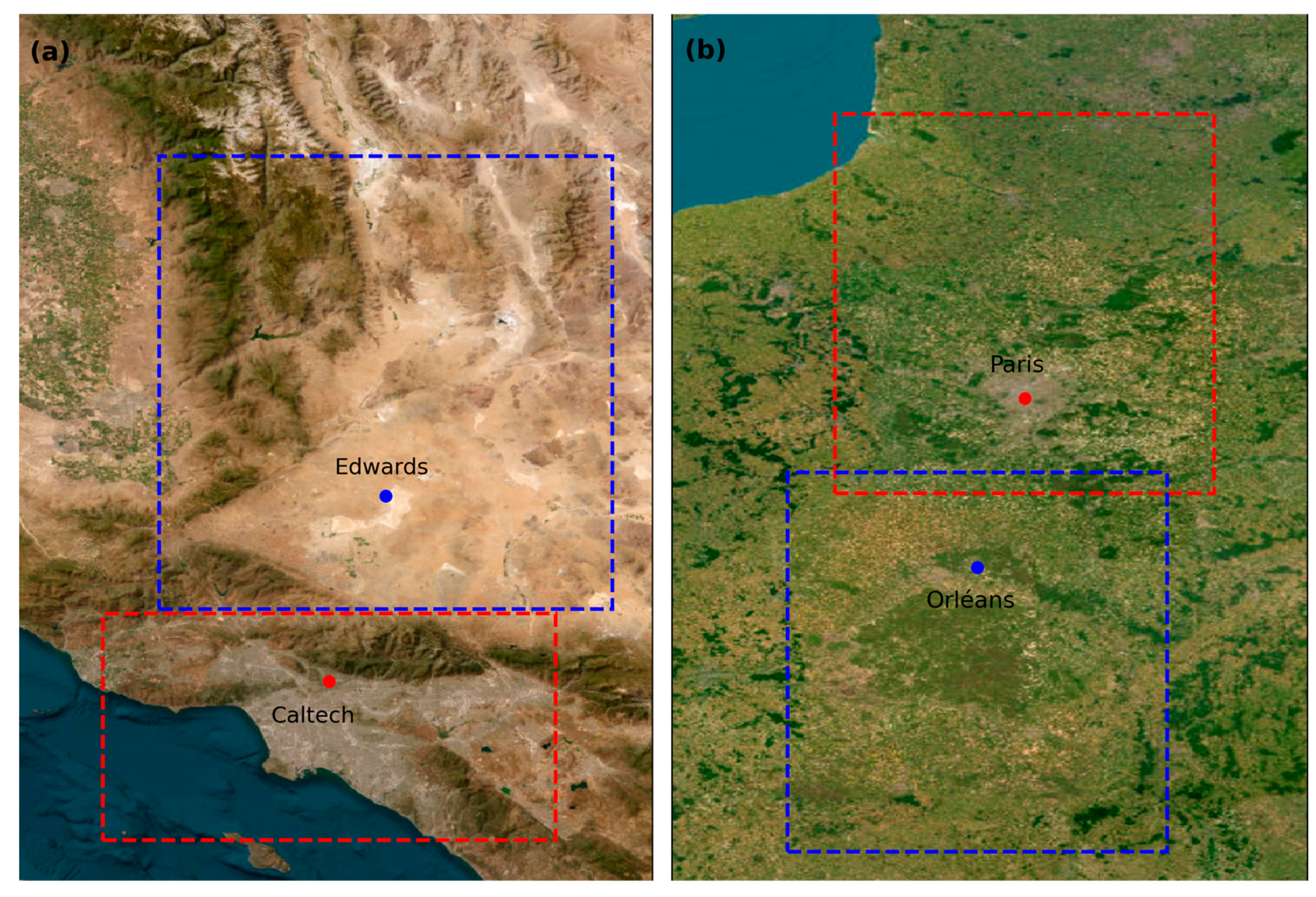
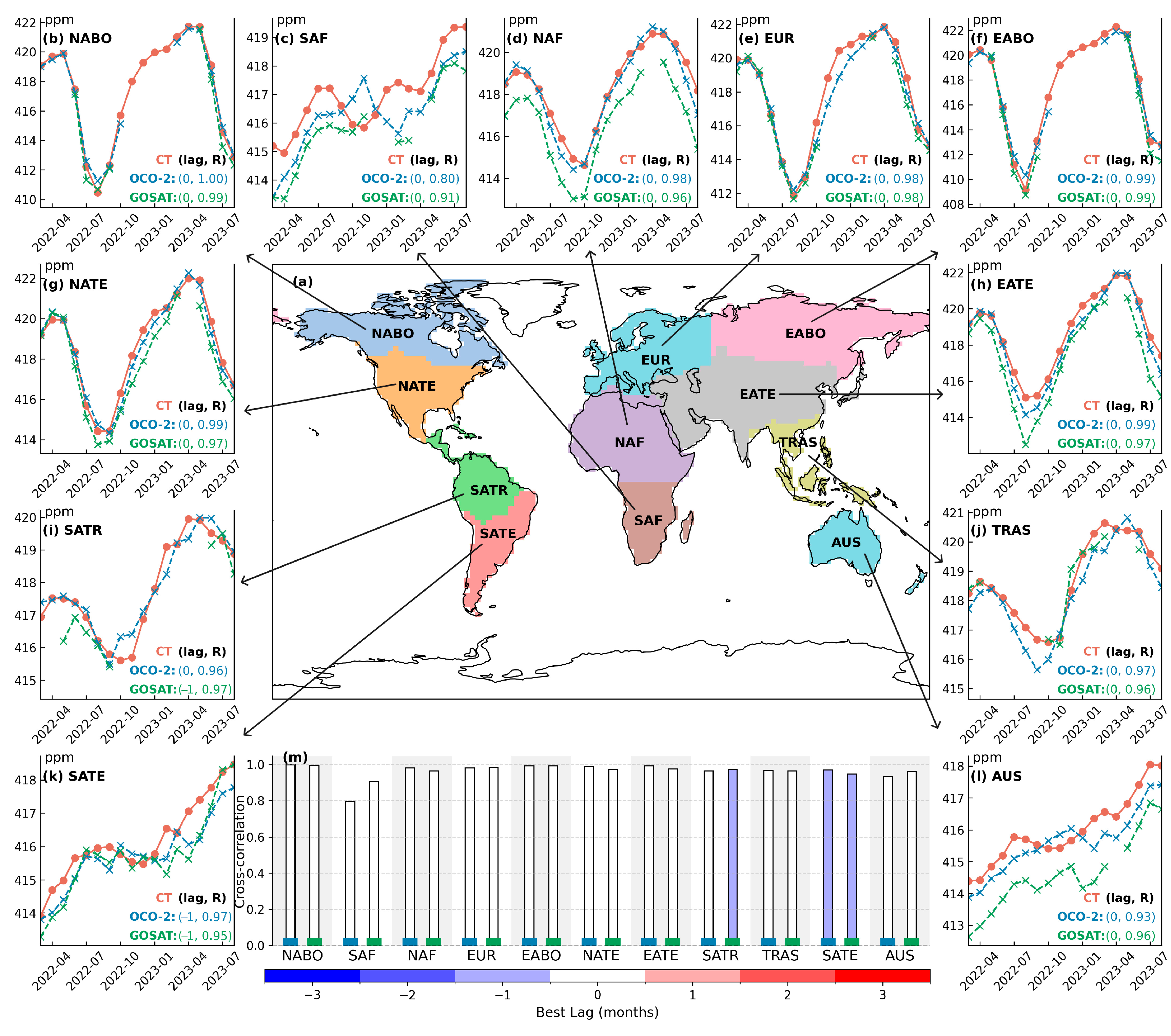


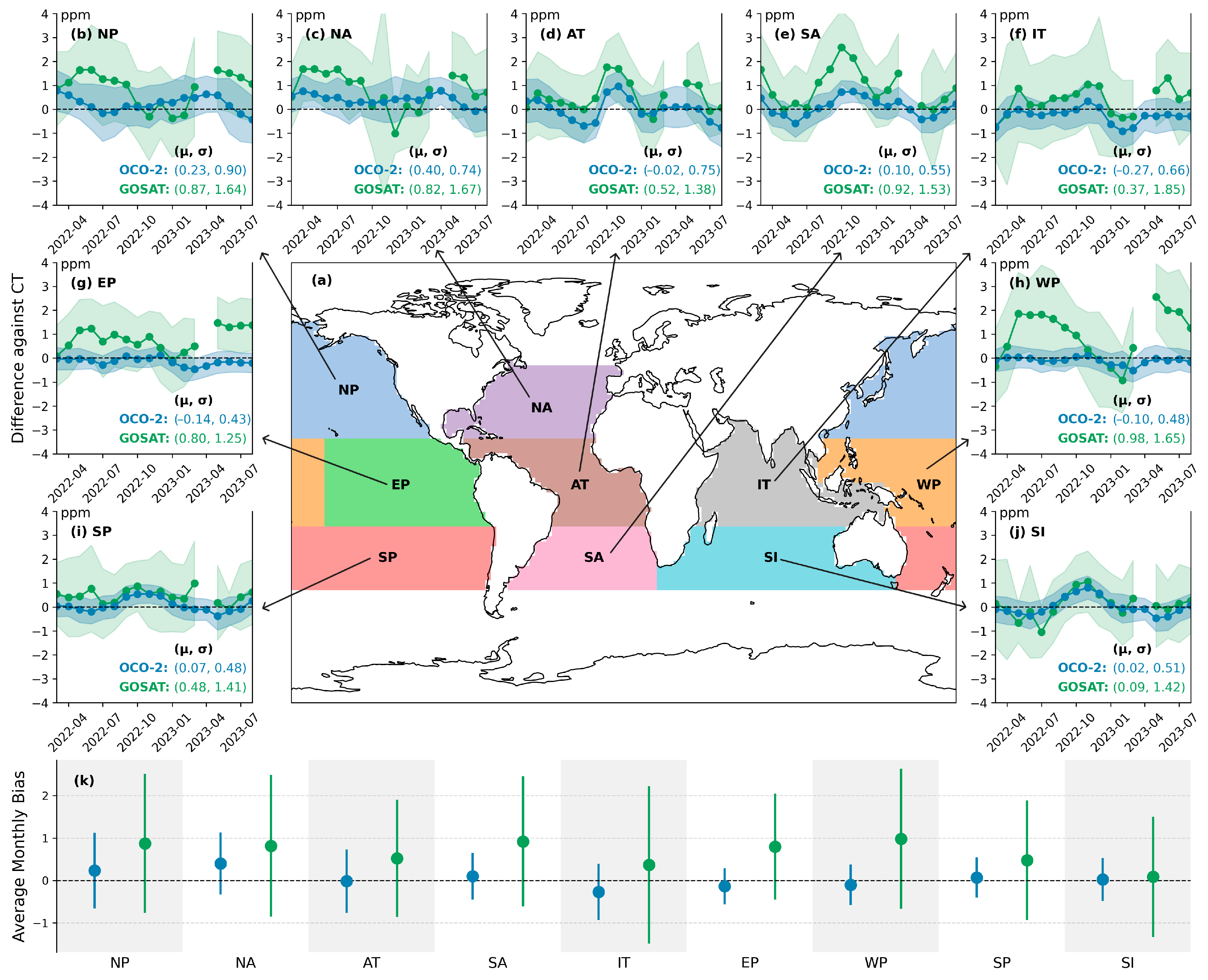
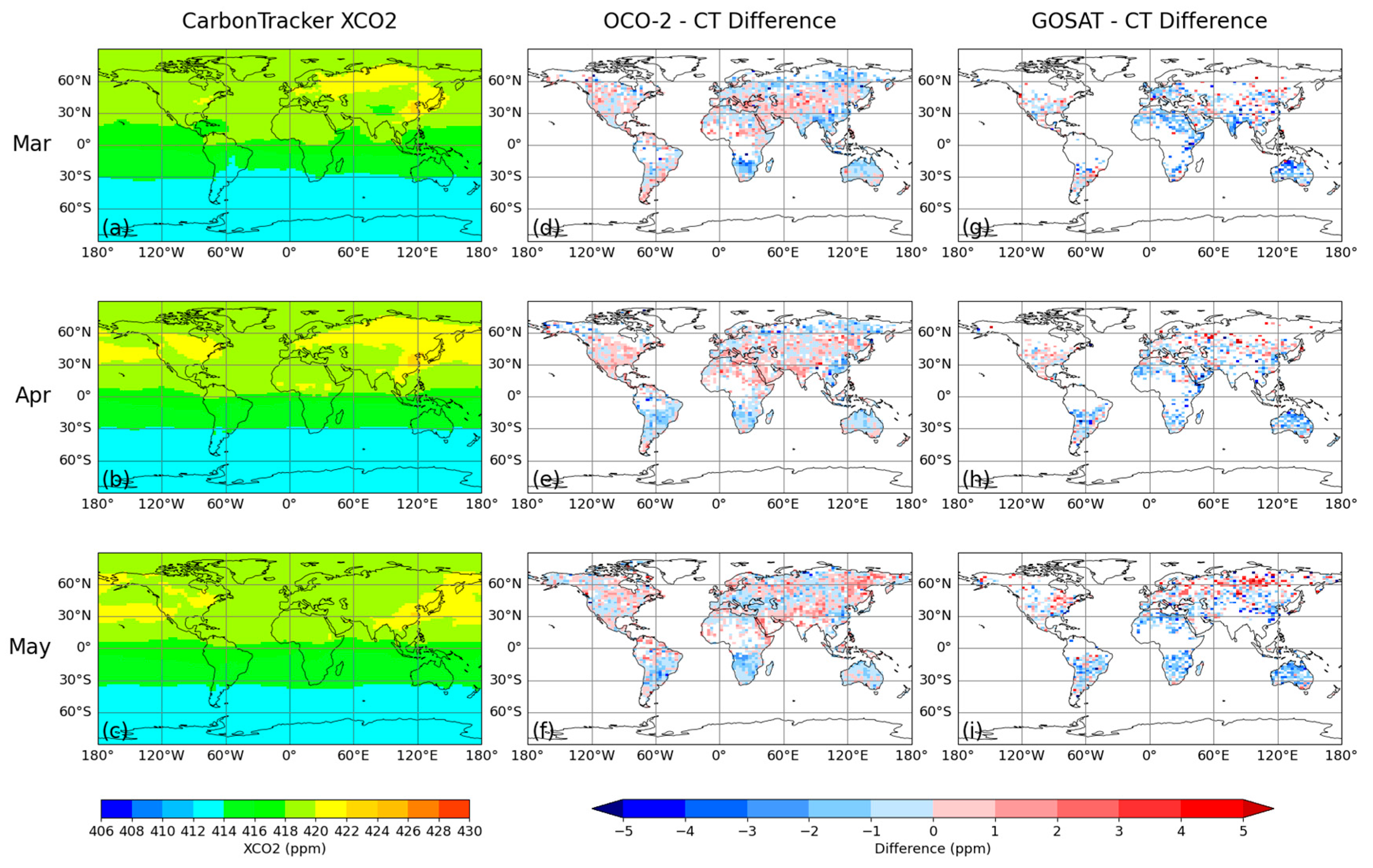
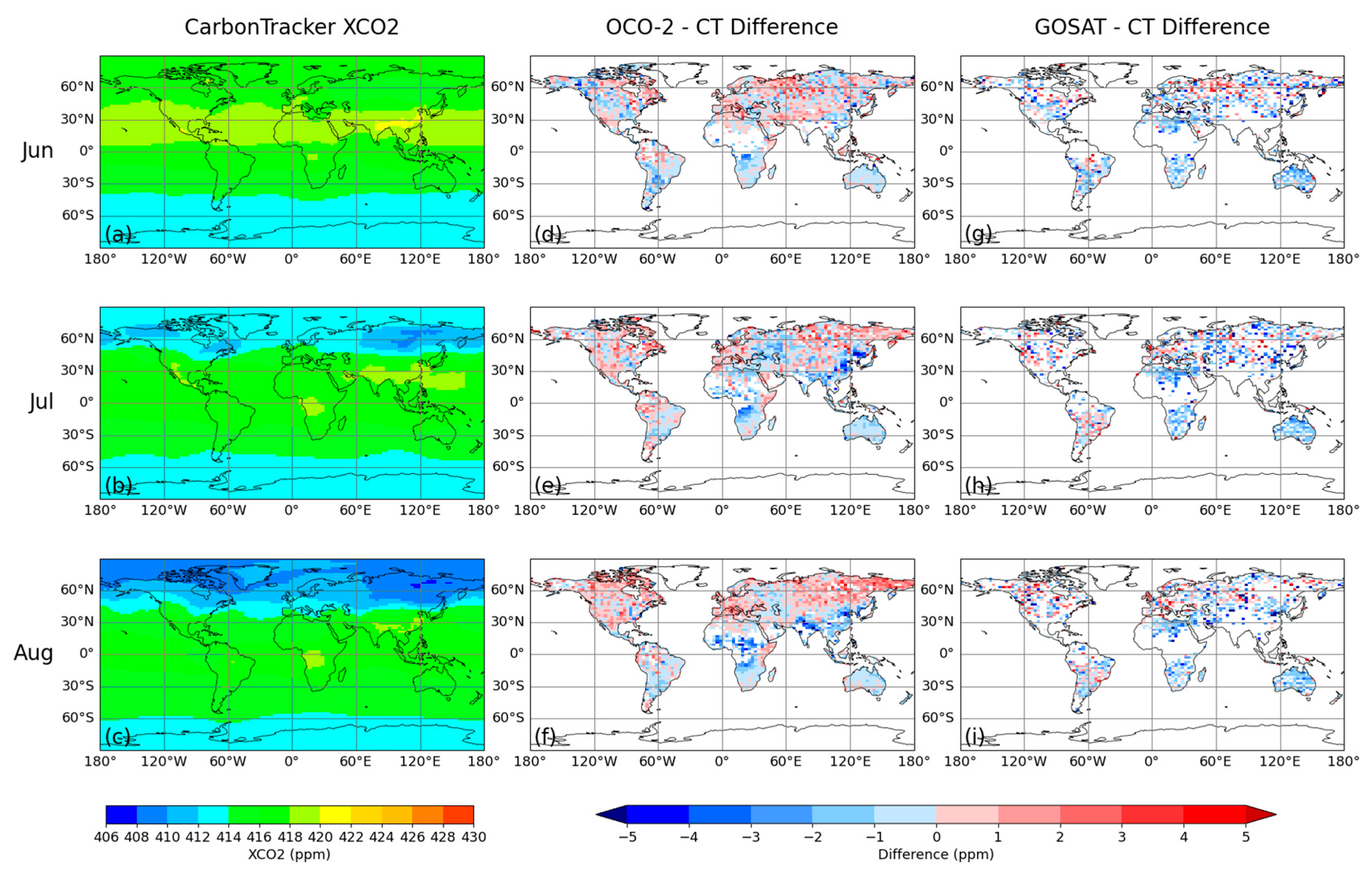
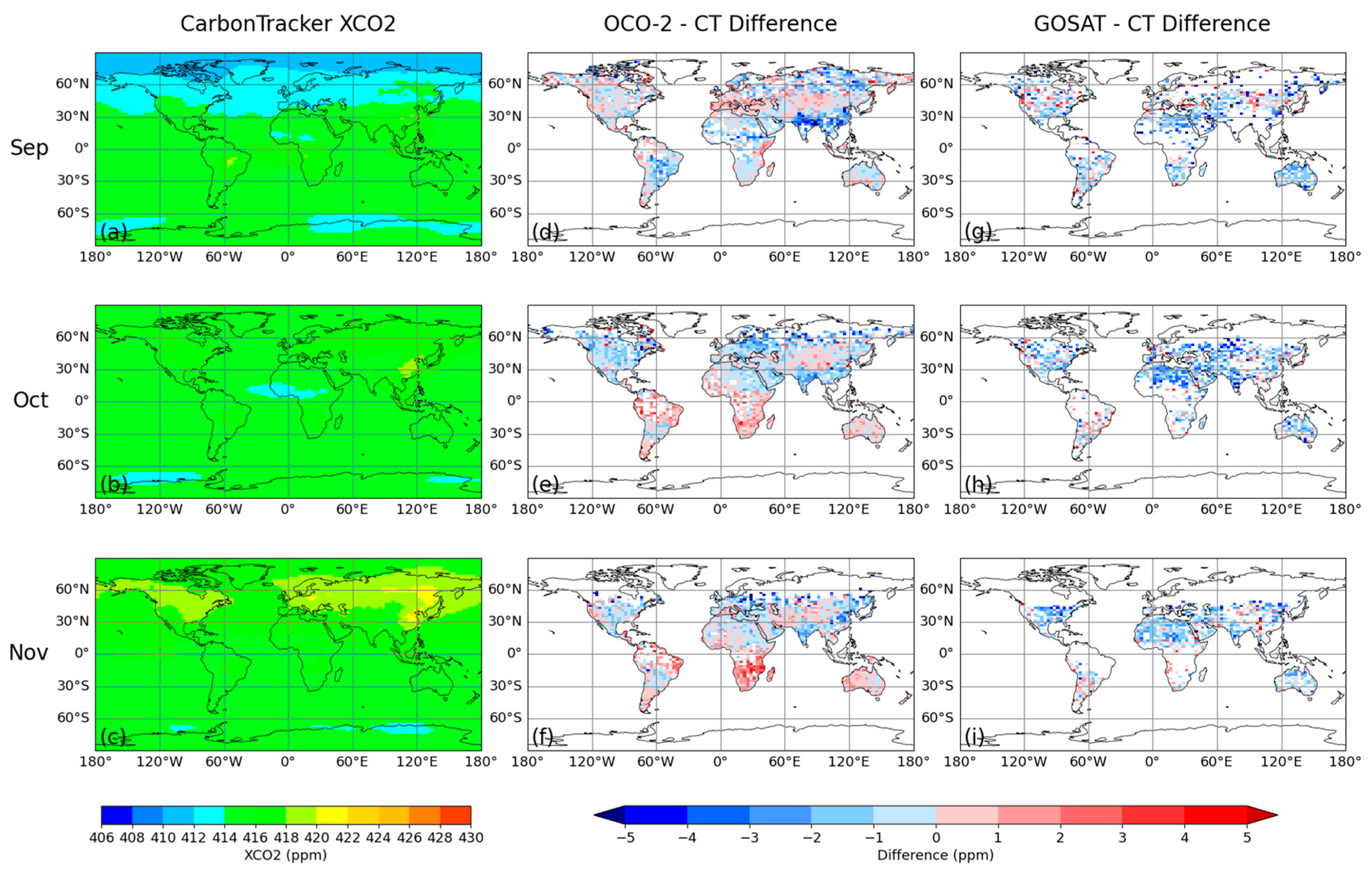
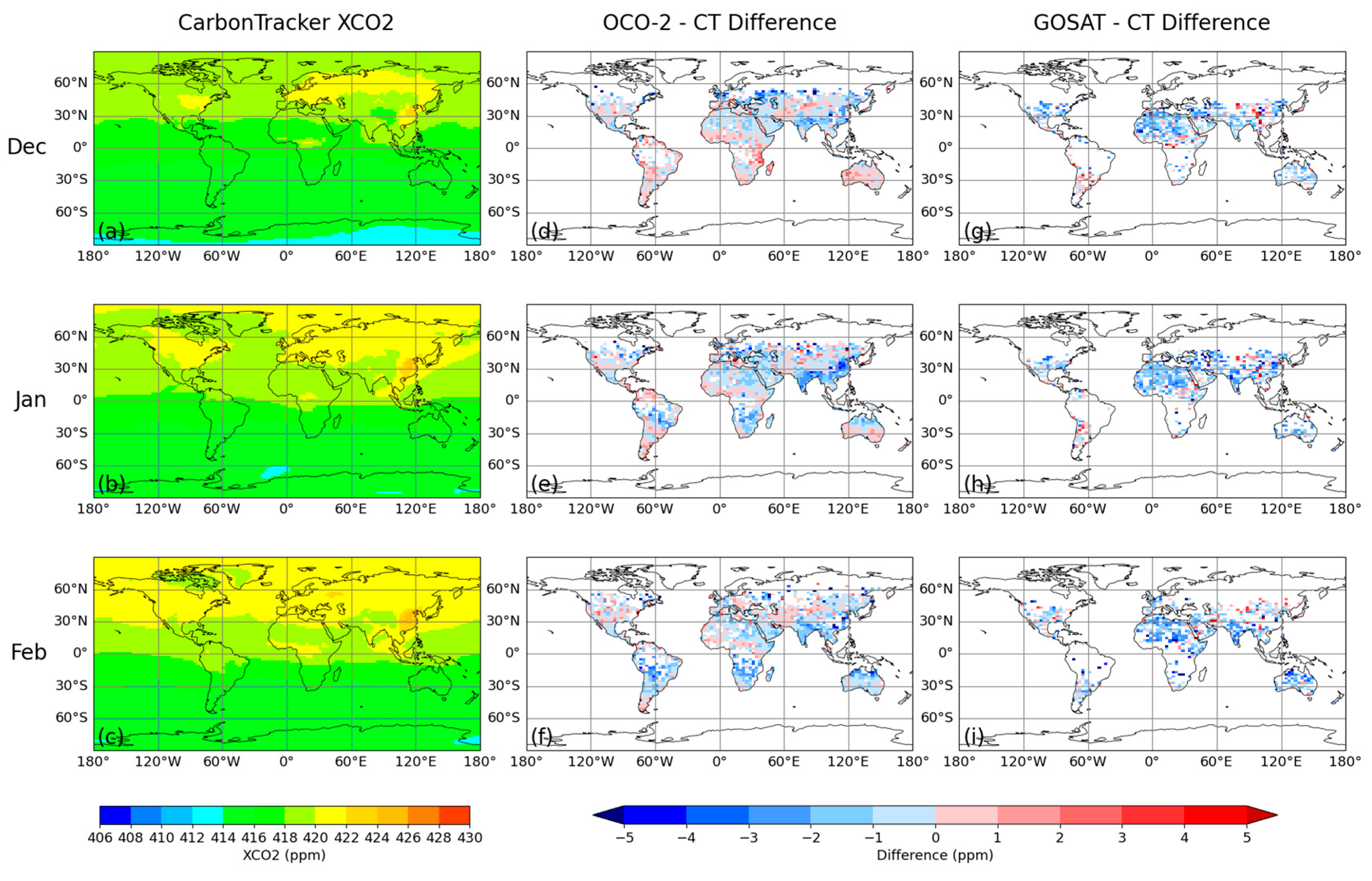
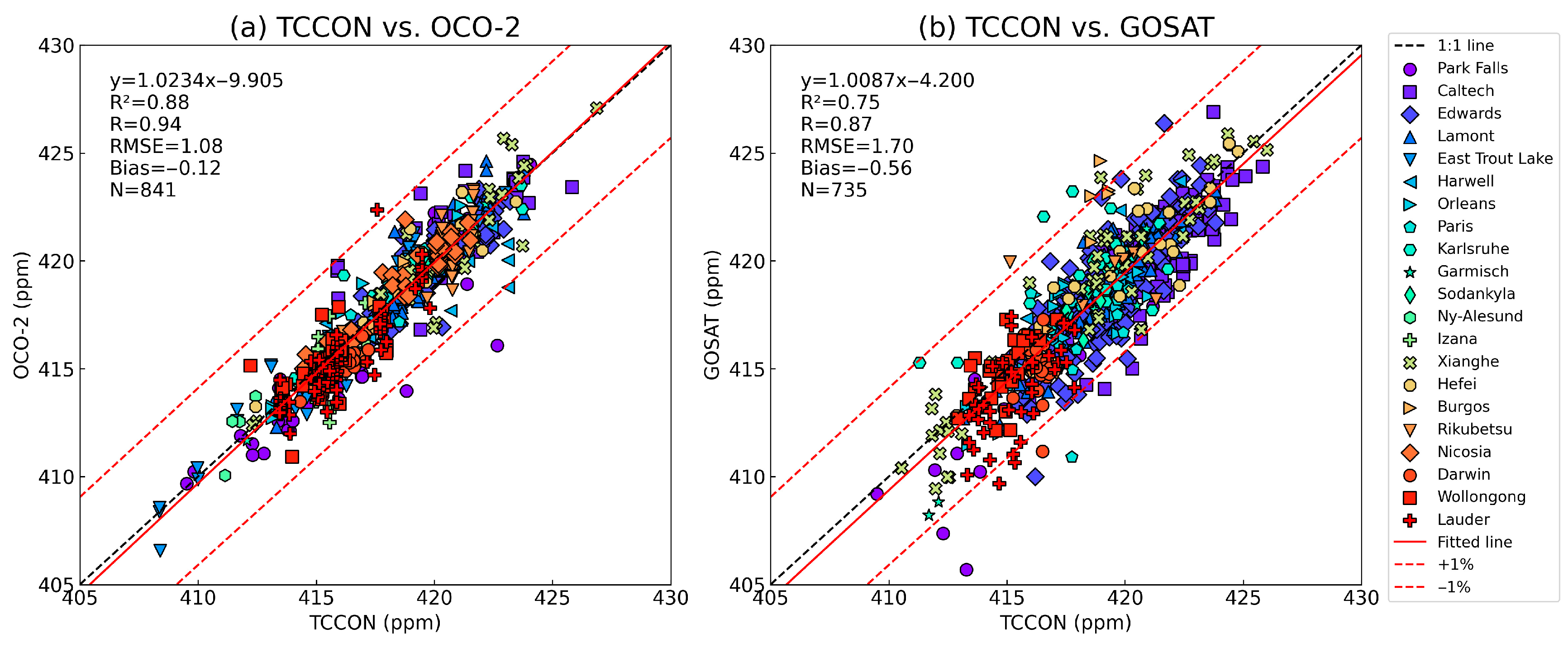

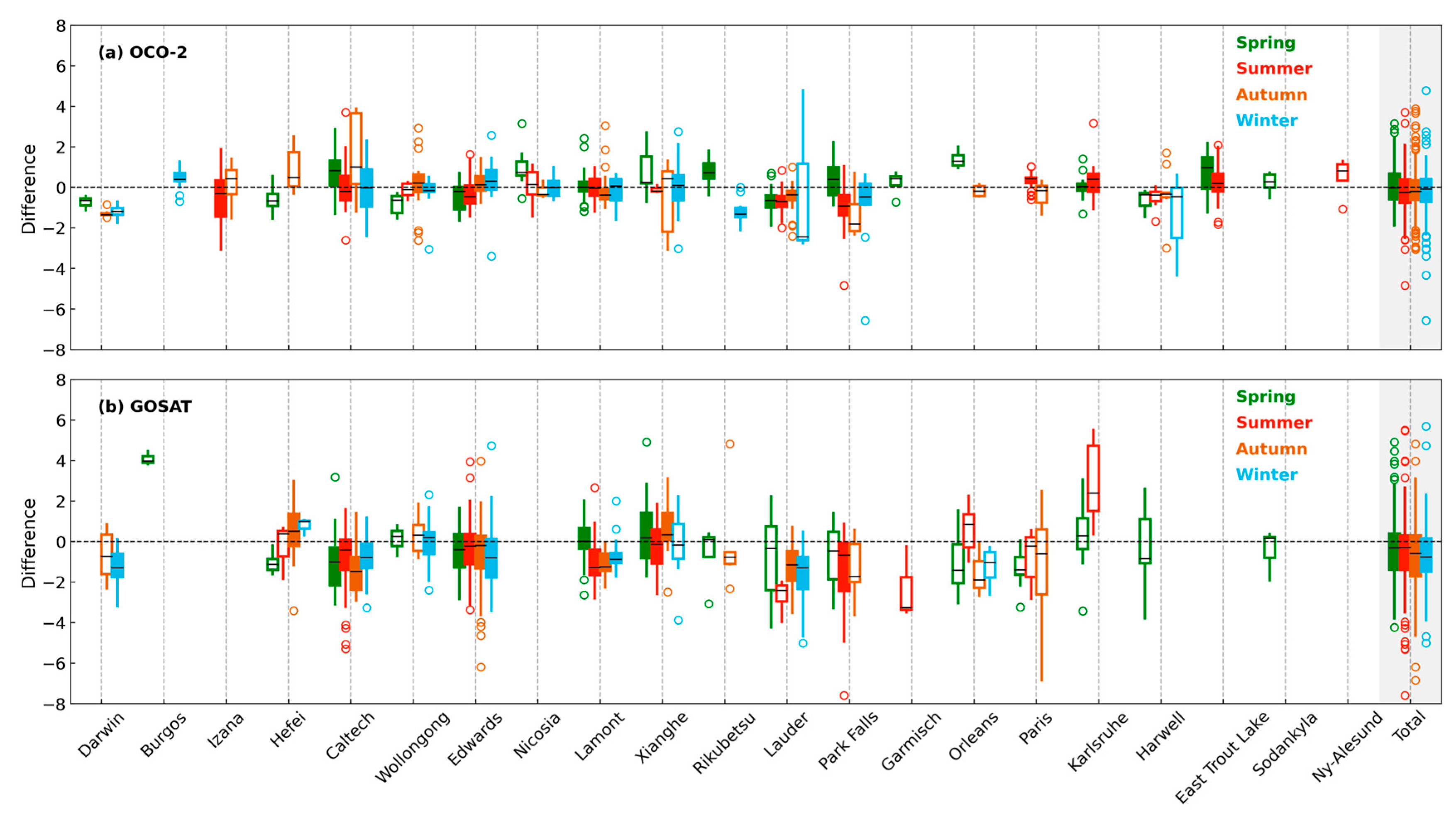
| Site | Site Location (Latitude, Longitude) | Start Date | End Date |
|---|---|---|---|
| Burgos [51] | 18.53°N, 120.65°E | 23 November 2022 | 24 July 2023 |
| Caltech [52] | 34.14°N, 118.13°W | 1 January 2022 | 21 April 2024 |
| Darwin [53] | 12.42°S, 130.93°E | 2 January 2022 | 27 December 2022 |
| East Trout Lake [54] | 54.35°N, 104.99°W | 1 January 2022 | 2 June 2024 |
| Edwards [55] | 34.96°N, 117.88°W | 1 January 2022 | 22 February 2024 |
| Garmisch [56] | 47.48°N, 11.06°E | 12 January 2022 | 4 May 2023 |
| Harwell [57] | 51.57°N, 1.32°W | 17 February 2022 | 30 June 2024 |
| Hefei [58] | 31.91°N, 117.17°E | 2 January 2022 | 25 December 2023 |
| Izaña [59] | 28.31°N, 16.50°W | 1 January 2022 | 30 August 2023 |
| Karlsruhe [60] | 49.10°N, 8.44°E | 19 January 2022 | 26 June 2023 |
| Lauder03 [61] | 45.04°S, 169.68°E | 1 January 2022 | 28 December 2023 |
| Lamont [62] | 36.60°N, 97.49°W | 2 January 2022 | 25 February 2024 |
| Nicosia [63] | 35.14°N, 33.38°E | 5 January 2022 | 10 May 2023 |
| Ny-Ålesund [64] | 78.92°N, 11.92°E | 18 March 2022 | 23 July 2023 |
| Orléans [65] | 47.96°N, 2.11°E | 10 March 2022 | 17 July 2023 |
| Paris [66] | 48.85°N, 2.36°E | 5 January 2022 | 20 December 2023 |
| Park Falls [67] | 45.94°N, 90.27°W | 1 January 2022 | 25 February 2024 |
| Rikubetsu [68] | 43.46°N, 143.77°E | 27 April 2022 | 25 July 2023 |
| Sodankylä [69] | 67.37°N, 26.63°E | 11 March 2022 | 30 May 2023 |
| Wollongong [70] | 34.41°S, 150.88°E | 1 January 2022 | 27 June 2023 |
| Xianghe [71] | 39.80°N, 116.98°E | 1 January 2022 | 29 May 2023 |
| Site | Latitude | Longitude |
|---|---|---|
| Caltech | −0.7° (33.64°N), +0.3° (34.64°N) | −1° (117.13°W), +1° (119.13°W) |
| Edwards | −0.5° (34.46°N), +1.5° (36.46°N) | −1° (116.88°W), +1° (118.88°W) |
| Paris | −0.5° (48.35°N), +1.5° (50.35°N) | −1° (1.36°E), +1° (3.36°E) |
| Orléans | −1.5° (46.46°N), +0.5° (48.46°N) | −1° (1.11°E), +1° (3.11°E) |
| The other sites | ±1° | ±1° |
Disclaimer/Publisher’s Note: The statements, opinions and data contained in all publications are solely those of the individual author(s) and contributor(s) and not of MDPI and/or the editor(s). MDPI and/or the editor(s) disclaim responsibility for any injury to people or property resulting from any ideas, methods, instructions or products referred to in the content. |
© 2025 by the authors. Licensee MDPI, Basel, Switzerland. This article is an open access article distributed under the terms and conditions of the Creative Commons Attribution (CC BY) license (https://creativecommons.org/licenses/by/4.0/).
Share and Cite
Li, Y.; Wu, K.; Yung, Y.L.; Wang, X.; Han, J. Analysis of the Current Situation of CO2 Satellite Observation. Remote Sens. 2025, 17, 3635. https://doi.org/10.3390/rs17213635
Li Y, Wu K, Yung YL, Wang X, Han J. Analysis of the Current Situation of CO2 Satellite Observation. Remote Sensing. 2025; 17(21):3635. https://doi.org/10.3390/rs17213635
Chicago/Turabian StyleLi, Yuanbo, Kun Wu, Yuk Ling Yung, Xiaomeng Wang, and Jixun Han. 2025. "Analysis of the Current Situation of CO2 Satellite Observation" Remote Sensing 17, no. 21: 3635. https://doi.org/10.3390/rs17213635
APA StyleLi, Y., Wu, K., Yung, Y. L., Wang, X., & Han, J. (2025). Analysis of the Current Situation of CO2 Satellite Observation. Remote Sensing, 17(21), 3635. https://doi.org/10.3390/rs17213635






